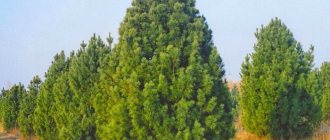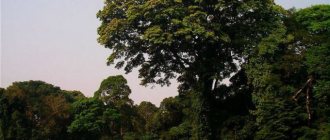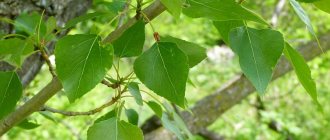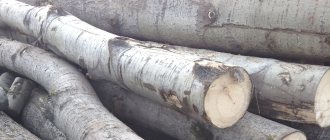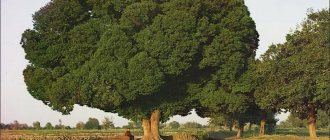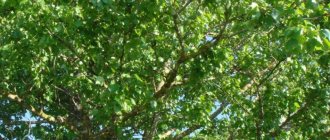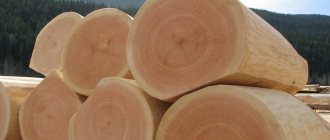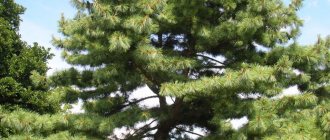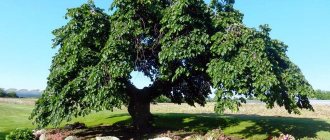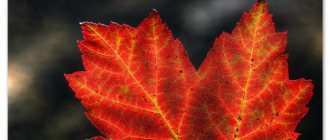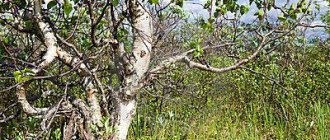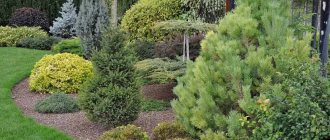At first glance, cedar lining does not strike the imagination. It has average strength, hardness, wear resistance, etc. But it is quite expensive, and it is surprisingly easy to breathe in a room covered with such a board. Where does this healthy spirit come from?
Cedar is a coniferous tree that “prefers” to grow in places with a healthy ecology, for example, in the South Caucasus or in the forests of Siberia. It is not surprising that it is classified as a slowly but still disappearing species. Its felling is strictly limited, and loggers often have to deliver wood from distant, inaccessible places. Why all this trouble?
Before answering this question, let's consider the main characteristics of cedar wood.
Strength.
Cedar does not resist mechanical stress very well. Compressive strength varies from 33 to 40.6 MPa, flexural strength - from 54.1 to 79.9 MPa. For comparison: for oak these figures reach 57.5 MPa and 107.5 MPa, respectively.
Density.
The density of cedar wood, depending on humidity, is 410–435 kg/m³. According to this characteristic, it is similar to pine and spruce.
Weight.
A cubic meter of cedar wood, depending on the type, humidity and other factors, can weigh from 360 to 570 kg/m³.
Hardness.
Cedar belongs to the softwood category, just like spruce and fir. Its hardness is 4 HB. Its ability to hold fastenings is 15-20% worse than that of pine.
So, the technical characteristics of cedar are not particularly impressive. So why is this average wood in all respects so popular? The answer lies in its unique chemical composition.
What cedar looks like: photo and description
Cedar belongs to the large Pine family, genus Cedar, or Siberian cedar pine.
This genus is of particular interest because of the universal value of its wood, needles and seeds. Cedar is also in demand in landscaping. Cedar in the photo
The cedar tree looks like a real giant: it has a powerful trunk, reaching a height of 25 to 45 m, depending on the type.
Unlike Scots pine, cedar needles are surprisingly soft, long, triangular, and collected in whorls of 5-6 pieces. And pine has two and very rarely three needles.
There are two types of shoots - elongated vegetative and shortened generative. The tree is monoecious. Male buds are in the form of spikelets looking up, red or yellow. The female ones - cones of 2-4 pieces - are located at the top of the shoot and are purple in color.
The description of cedar roots is akin to the tree itself: the root system is as powerful as the above-ground part, which allows the plant to withstand all natural disasters and be unpretentious in cultivation. An adult cedar does not require agrotechnical care.
Its antimicrobial properties are also very valuable. The air around these trees is practically sterile. Many cedars have been planted by amateurs in summer cottages, household plots and garden plots in central Russia. It cannot grow in dry sandy places, but prefers sandy loam or loamy, moist, fertile soils.
Almost all types of cedar pines in forest plantations begin to bear fruit at 30-60 years, sometimes later, and in gardens where care and feeding with fertilizers are carried out in a timely manner - at 15-20 years and continue to bear fruit up to 250-300 years. A good harvest of large pine nuts occurs in those areas where 2-3 cedars grow in a group, since conifers are cross-pollinated trees. The seed development cycle of cedar lasts one and a half years.
Four types of cedar grow in Russia - Siberian, European, Korean and Siberian dwarf cedar.
You can familiarize yourself with the varieties of cedars and their photos on this page.
Features of cedar
The height of a cedar can reach up to 50 meters, while the diameter of its trunk can be from 2 to 3 meters. The trunk and stems are covered with gray bark. While the plant is young, its bark is smooth and thin, but over the years it becomes thicker and a large number of cracks appear on it. The root system easily adapts to new conditions, while its shape directly depends on the characteristics of the soil, but it is often superficial with many adventitious processes. One of the main factors that influences the formation of a branched root system is the presence of moss cover.
Three- or tetrahedral needle-shaped needles are represented by pointed needles. In some species it is soft (for example, Cedrus atlantica), while in others it is highly rigid (for example, Cedrus libani). The color of the needles can vary from silver to bright green.
This tree blooms in autumn. It is monoecious, that is, spike-shaped inflorescences consisting of female or male flowers are formed on its branches. The elongated and erect cones have a light blue tint. At the same time, ripe cones turn brown. The plant is distinguished by late fruiting; the first cones form on the tree only after it is 20 to 25 years old. The ripening of the cone lasts from 2 to 3 years, with the seeds falling out in the autumn-winter period.
Cedar (Cedrus) is often confused with cedar pine. This conventional name refers to several species belonging to the genus Pine (Pinus), for example: European, Korean, Siberian and dwarf pine. Such trees have edible seeds called “pine nuts.” But from a scientific point of view, they are not cedar fruits or nuts; a more accurate name for such a product could be “pine seeds.” The fruits of cedar are not eaten.
The average lifespan of such a tree is about 1 thousand years. The oldest cedar is located in Japan on the island of Yakushima; its age, according to various sources, is from 3 to 7 thousand years. Over the years, cedar begins to grow differently. The young tree is characterized by rapid growth, while the adult plant grows moderately, during the year its growth ranges from 20 to 30 centimeters.
Characteristics
Representatives of the Cedar genus are truly gigantic trees, the height of which in wild conditions often reaches 40–60 m . The crown is massive and spreading, the bark is dark gray in color, smooth on young plants and scaly on older ones. The branches can be shortened or elongated, and the latter contain spirally arranged needles. To the touch it is hard and prickly, with three or four edges, united in bunches of five needles. Depending on the type of plant, its color can vary from blue or dark green to gray-silver.
The tree's spikelets are located singly at the ends of short branches. All of them are erect, supplemented with tufts of needles in the lower part. Female specimens reach a length of 5 cm and have numerous, spirally arranged stamens, with two interconnected anthers covered with cracks. The pollen itself is enclosed in air sacs.
Varieties and varieties of cedar wood
Cedar belongs to the family of coniferous, evergreen trees. The cedar pine has quite impressive dimensions - the height of some specimens reaches fifty meters. If you look at the photo of a cedar tree, you can see how diverse the species shades of this tree are.
The characteristic features of cedar include:
- dark brown bark color
- specific woody smell
- single, erect cones
Today, cedar wood has a lot of varieties, some of them are worth dwelling on in more detail.
Lebanese cedar appearance
An adult tree is characterized by the presence of a spreading crown, which is contrastingly divided by tiers of branches. Younger specimens have the shape of a pointed cone. The tree is not picky about the soil on which it grows and thrives on both limestone and loam.
Lebanese cedar is dark green in color, the length of the needles reaches 30 mm. The cones of cedar trees are light brown in color and reach a length of 120 mm.
Atlantic cedar growth features
This variety of cedar is characterized by rapid development at an early age. It is able to tolerate both frost and drought well. A large amount of moisture can be detrimental to it, so planting in soil with a high groundwater level should be avoided.
Far Eastern
This is the most frost-resistant cedar. Its lifespan reaches 600 years. Far Eastern cedar grows in a mixed forest. Next to him there is always a linden, birch, and fir tree. Its cones, like those of the Siberian cedar, have edible nuts. The cedar begins to bear fruit after its twentieth birthday.
The tree respects moderate watering and dry soil. Where Far Eastern cedars grow, there are always healthy trees and shrubs, and the air is fresh and even healing. Turpentine and rosin are obtained from cedar resin.
Photo of Far Eastern cedar
Himalayan cedar main differences
There are several varieties of trees of this variety, which were developed through selective breeding. It differs from its counterparts in its soft crowns and unusual arrangement of cones.
The tree is not demanding of environmental conditions and can grow in almost any environment.
Atlas
An evergreen tree up to 40-50 m high and a trunk up to 2 m in diameter. The needles are thick, short (up to 2.5 cm), silvery. The wood is aromatic and smells like sandalwood. The tree is drought-resistant, unlike other species, and can withstand prolonged frosts down to –20 °C.
Short-coniferous
A small tree up to 15 m tall with very short bluish-green needles (up to 10 mm). A variety of Lebanese cedar.
Cedars easily produce interspecific hybrids. Hybrid forms between the Himalayan and Atlas species are common.
European
Scientists classify the tree as a member of the pine family. This cedar likes to grow on south-facing slopes at altitudes of 1,500 to 2,500 meters above sea level in Central Europe and Russia. The maximum tree height is 25 meters. European cedar is very similar to Siberian pine. Only its growth is lower and the trunk is thinner, and the bark is more beautiful and stronger.
And this is what a European cedar tree with cones looks like in the photo
Korean
The tree can grow up to 40 - 50 meters with a trunk diameter of up to 1.5 meters. Scientists also classify this species as a pine tree. The bark has a reddish tint, in youth it is gray, and in more mature age it is brown. Young cedar has large cones of red color with a purple tint, but there are few of them. The old one has many times more, but the size is small.
The tree grows in Korea and the adjacent Russian territory. Korean cedar is a monoecious tree. Male spikelets are yellow. But the needles are bluish-green.
Photo of Korean cedar
Cedar elfin wood
A small shrub that sends its branches along the ground.
Siberian cedar description
The most widespread and most studied is Siberian cedar. In young trees the crown looks conical. Over time, as the crown matures, it acquires a flat, spreading appearance.
Decorative varieties
Based on Lebanese cedar, breeders have developed several compact varieties suitable for growing in gardens and parks:
- Sargentii is a semi-dwarf tree with weeping shoots, grows very slowly, by the age of 10 it reaches a height of about 1 m, tolerates shaded areas well;
- Beacon Hill - distinguished by bright green needles, has weeping branches, a narrow conical crown, dark golden bark, prefers well-lit areas;
- Glauca - the tree's needles are grayish-blue, the crown shape is original, broken, the shoots are weeping;
- Nana is a slow-growing shrub with a crown height of about 80–90 cm, dense, dark green needles, asymmetrical, wide shoots;
- Var stenocoma is a straight-trunked, low tree up to 3 m, externally reminiscent of a young spruce: the crown has a neat conical shape with a sharp tip, the shoots are directed upward, the needles are dark green.
Types of cedar pine
Despite the fact that, according to the latest scientific data, the Canadian, Korean and Siberian species are only close relatives of real cedar, the names familiar to everyone remain among the people. Canadian cedar belongs to the Thuja genus of the Cypress family.
Korean cedar pine
Korean, or Manchurian cedar is a coniferous tree of the pine genus, common in eastern Asia, China, Korea, Japan and the Russian Far East. The tall, powerful tree has a dense cone-shaped crown and shallow roots. The needles are bluish-green, long, and grow in bunches of 5 pieces.
The cones ripen within a year and a half and fall off in autumn or early winter. Each cone contains many nuts. The Korean species bears fruit once every few years.
Siberian cedar pine
Siberian cedar, or Siberian pine, is an evergreen tree, only slightly smaller in size than its famous relative. It lives up to 500–700 years and is distinguished by a dense, often multi-peaked crown with thick branches. The needles are soft, long, with a bluish bloom. The tree grows a powerful root system, and on light sandy soils it develops anchor roots that penetrate to great depths. Compared to cedars, it is shade-tolerant, with a short growing season.
The plant has male and female cones. They ripen within a year and a half and fall off in early autumn. Each cone contains up to 150 nuts. One tree produces up to 12 kg of pine nuts. Siberian cedar begins to bear fruit late, on average at 50–60 years of age.
The settlement of the tree involves nutcracker squirrels and chipmunks, which carry seeds over long distances.
Plant propagation
Male spikelets and female cones grow on the same plant. As a rule, male microstrobiles of a dark red color are located at the bottom of the crown, while female cones grow on dense branches at the top.
In the middle of the crown there are both cones and microstrobili. Without a doubt, the sight of a mature plant is a memorable sight.
The period of seed reproduction of cedar, as a rule, occurs in the first month of summer - June, but the processes of development and reproduction directly depend on meteorological conditions and the weather regime of the area.
However, flowering can only be observed in certain seasons. Pollination of trees occurs at the beginning of the calendar summer, and fertilization occurs only a year after pollination.
The cedar pollen is equipped with special devices - air cavities, so the spread of pollen is not difficult.
In addition, there is so much of it that the mass of pollen can be equal to the mass of seeds. Cedar pollen, carried by the wind, ends up in water bodies and becomes food for fish fry. Frosts in late spring can affect the fertility of trees - cedar flower spikes can be damaged.
Features of seeds and cones
Seed ripening occurs in the second year after the flowers bloom. The tree bears fruit once every couple of years, but a decent harvest can be harvested once every 5 years, and an excellent one - once every 10 or even 15 years. Moreover, further north, due to cold temperatures, the cones ripen much longer. Siberian pine trees in the taiga of the Ural Mountains begin to produce a relatively large harvest (which is called commercial) only a century after planting.
READ Amazing poplar tree
Residents of the region are keen on collecting pine nuts; they are very familiar with the appearance of the pine cones and the methods of processing the raw materials. On average, 1 hectare of pine nuts can produce from 150 to 250 kg of pine nuts.
Growing cedar
It is possible to grow cedar pine under artificial conditions. For normal growth and fruiting, it does not need a special climate, but suitable soil. Among coniferous trees, cedar is the leader in resistance to gas-polluted regions, so it can easily grow in the city.
The tree needs a lot of potassium. But excess nitrogen can have a bad effect on the roots. At a young age, cedar does not exhibit active growth, so its plantings are often overgrown with aspens, fir trees, and birch trees.
It is important to clean the area in time and place cedar seedlings away from pine trees, which like to nestle comfortably in the shade of the cedar’s spreading paws. In decorative terms, cedars look beautiful against the backdrop of birches, but given their powerful impact on neighbors, spacing must be observed when planning plantings.
When preparing for such an important event, you need to plan everything. When marking the area, maintain an interval of 9 m. Buy seedlings that were grown in containers. This is the best planting material: the root system is not damaged, the tree takes root well and begins to grow within a year or two.
When planting a plant from a container into the ground, pay attention to the condition of the roots: if they are twisted, you need to free them and place them in the hole so that they do not become deformed in the future. If the soil is heavy, add sand to the soil.
Trees do not require litter, since it contains parasites that damage the mycorrhiza of the root.
Cedar pine trees need to mulch the soil to increase fertility and saturate some of the roots with air. Mulch will save the tree from freezing in winter and will retain moisture if the trees are grown on light sandy loam.
In order for adventitious roots to develop normally, mulch must be added annually, because it is due to them that the tree actively grows. In dry summers, abundant watering is necessary to improve gas exchange; the tree crown must be sprayed. Young seedlings thrive in the shade, but mature cedar needs space and good lighting.
Cedar cone: photo, composition and properties
The taste of nuts and their nutritional properties are best preserved in their own “packages” - cones.
The benefits of eating nuts are immeasurable. Just 100 grams of kernels replenish the daily requirement of the human body for amino acids. Nuts also contain vitamins A, B (1, 2 and 3), D, E and a huge amount of microelements: iron, magnesium, iodine, manganese, calcium, potassium, phosphorus, silicon, copper, boron, titanium, nickel, sodium, aluminum , silver and molybdenum.
Of the organic acids in nuts, citric acid is present. Nuts also contain proteins, starch, fiber, and a little sugar (sucrose).
The nut kernel is an excellent source of fat.
The appearance of a cone, obtaining seeds
The development of a pine cone occurs over approximately three years. The seeds themselves can be stored in the cones for up to 20 years. These seeds can germinate without preparation before sowing. But stratification at temperatures from +3 to +5°C for about 14 days significantly accelerates their germination and increases germination (more than 50%). The seed planting depth should be 1 cm.
Before getting the seeds, the pine cone must be soaked about 2 or 3 times, then dried, after which it will open.
A real Himalayan cedar cone matures for 1.5 years and then falls off like a fir cone. Moreover, the seeds of this species retain their viability only for about 5 months; therefore, it is advisable to sow them after harvesting in the first spring. Pre-sowing treatment is also not required. And their germination rate is 70%.
The cedar blooms in the spring, and the cones with seeds ripen the next year only in August-September (i.e., after 17-18 months).
Cedar cone in food
Pine nuts are widely used in the food industry. Cream, butter and milk, which have a fairly high calorie content, are made from cedar fruits.
In Siberian factories, table oil with excellent taste is obtained by cold pressing, and technical oil is obtained by hot pressing. The remaining cake after production is used to prepare halva. By grinding the nuts (very finely) with water, milk is obtained. Cream is obtained in the same way, but with less water.
Growing methods
Growing cedar at home is not an easy task, but if you follow the planting rules, you can achieve excellent results. At the initial stage, to grow coniferous plants, it is necessary to create optimal home conditions that will correspond to the natural habitat. Within a few years, the first successes will be noticeable. Beginners are wondering whether it is possible to grow cedar from pine nuts or is it better to purchase seedlings?
Growing cedar from seeds
For planting, use nuts no older than two years old. But it should be remembered that freshness affects germination. Nuts collected in the fall and planted in the spring germinate at an rate of 85%. Before planting, it is necessary to stratify the seed material.
Seed stratification:
- The collected seeds are soaked in hot water for 2–3 days. The water is changed every day. Nuts that float to the surface are thrown away.
- Then they are treated with potassium permanganate or fungicide.
- The nuts are mixed with wet sand or sawdust.
- Next, the seeds are transferred to a cloth bag.
- For storage in the refrigerator, use a pre-prepared wooden box. Holes are made in the walls for ventilation.
- The box is put into the cellar or refrigerator until spring (3 months). The temperature should be within +4 +6 °C.
- The bag of seeds is regularly ventilated and moistened.
- Any suspicious seeds are discarded.
The optimal time for planting in the ground is from April to May. If nuts are sown without prior stratification, they will germinate in about a year. Plants are planted in open ground at the age of 2–3 years. The height of young cedars should be at least 1 meter.
Growing cedar seedlings
For planting, seedlings aged from 6 to 10 years with a closed or open root system are selected. The earthen ball of seedlings with a height of 1 to 2 meters should be at least 50–60 cm in diameter. During transportation, the ground is wrapped with a wet rag. It is advisable not to delay landing. Gardeners recommend planting plants immediately after purchase.
How to grow cedar from a seedling:
- It is recommended to plant seedlings immediately in a permanent place.
- They dig up the ground for planting in advance. 1 meter of loose soil per plant.
- The minimum distance between large varieties is 5–6 meters; low-growing varieties are planted 2–3 meters apart.
- The depth and diameter of the hole should exceed the size of the earthen ball by 30%.
- Clay soils are diluted with sand and peat.
- Organic fertilizers are applied: rotted manure, compost, ash, peat, fallen pine needles or leaves.
- A support for the seedling is strengthened in the hole.
- Then the tree is transferred. The root collar should be flush with the edge of the hole.
- Fill in the remaining soil and compact it.
When planting a seedling with a closed root system, it is necessary to straighten the roots before burying. If rooting is successful, the tree begins to grow the next year. Annual growth is from 5 to 10 cm.
Suitable for single and group plantings
The steep slopes of Siberian cedar. Photo: navro.org
What does cedar look like:
- An evergreen tree with soft and long needles from the Pine family is called Siberian Cedar (lat. Pinus sibírica). In the wild, the plant grows in Siberia, Crimea, the Caucasus, Altai, and the Urals. Of particular value are not only trees as a building material, but also nuts containing large amounts of microelements and vitamins.
- The giant with a powerful trunk reaching a height of more than 40 m and a complex root system with adventitious roots is a landmark of its habitat. A distinctive feature is the plastic needles, collected in bunches of 6 needles. The tree is monoecious, male buds and female cones are formed on one plant, pollination occurs with the help of wind.
- Cedar begins to bear fruit at the age of 30-60 years. Trees that grow in groups, between which cross-pollination occurs, show greater productivity. The period of seed ripening lasts one and a half years, and the lifespan of the tree reaches 800 years.
- Butter and milk are prepared from pine nuts. Many different tinctures and extracts used in folk medicine are prepared from the needles, and ointments for healing wounds are prepared from the resin. The Siberian species of cedar is of great importance for the food industry. Cedar oil has the most valuable beneficial properties for the human body.
The author of the video claims that the amount of ascorbic acid in the needles increases in the cedar tree in winter. And if you consume milk from cedar seeds, you can even cure tuberculosis:
Healing properties of cedar wood
The raw materials obtained as a result of processing contain large quantities of biological active substances that can help in the fight against many diseases.
Coniferous needles of cedar tree
The composition of cedar needles is rich in vitamin A and has a high content of essential oils. In addition, cedar leaves are rich in microelements such as manganese, phosphorus, iron, etc.
Ascorbic acid, contained in large quantities, is also a valuable raw material in the pharmaceutical industry.
Cedar tree resin (resin)
The resin of cedar trees contains up to 1/5 of gum turpentine. Due to the presence of oxygen compounds, vitamins C and D, products obtained from it, as well as cedar tree oil, have antibacterial and regenerating properties.
Application of pine nut kernels
Cedar tree seeds contain large amounts of fat (more than 60%). In addition, the protein contained in the kernels contains amino acids, in particular arginine, which is an essential acid.
Healing capabilities of oil
Oil is made from nuts. This thick amber-colored liquid with a nutty aroma is a full-fledged analogue of olive oil. For minimal contact with air, it is better to keep it in a glass container with a narrow neck in a cool and dark place.
Natural antioxidants that are in its composition save the product from rancidity, but still, to extend the shelf life, the rules must be followed.
The sediment that eventually appears at the bottom is not dangerous to humans: it contains useful phospholipids and microelements.
Cedar oil helps control cholesterol levels and promotes weight loss. The presence of terpenes in the product provides such capabilities.
The oil contains many substances: vitamins A, B1, B2, B3 (PP), B6, D, E, F
What are the benefits of cedar nuts
Cedar is one of the most valuable wood species (in an economic sense). It is very decorative and looks impressive both in single and group plantings. Hedges improve the microclimate of the area and attract forest animals. The seeds (nuts) are eaten - they are very healthy.
Tree sap (resin) is used in medicine. Cedar wood is soft, the texture is beautiful, the material is easy to process, so it is often used for construction and carpentry work. Wood is used to make pencils and furniture. The material has a comfortable aroma and resonating capabilities, which is why musical instruments are made from it - guitar, harp, piano.
The seed shells are used as mulch. Resistance to temperature changes allows the tree to be grown in parks. Tannins, which cedar is rich in, are used in the manufacture of leather. Conifer needles are processed to produce vitamin flour (it is used in animal husbandry).
Many forest inhabitants - squirrels and nutcrackers - feed on cedar nuts and spread cedar seeds. They are quite high in calories: they contain 65% oil, a lot of vitamins, and protein (up to 20%).
Cedar needles contain vitamin C and carotene, while tree buds contain essential oils and trace elements. Cedar needles are an excellent phytoncide (cleanses the air and saturates it with many useful organic compounds).
The pine nut kernel contains 55-66% fat, 13.5-20% protein, starch, sugars, vitamins. Living in such conditions not only improves health and increases the chances of a long life - the satisfaction of seeing the results of one’s efforts, the so-called psycho-emotional factor, will contribute to the successful treatment of many diseases.
